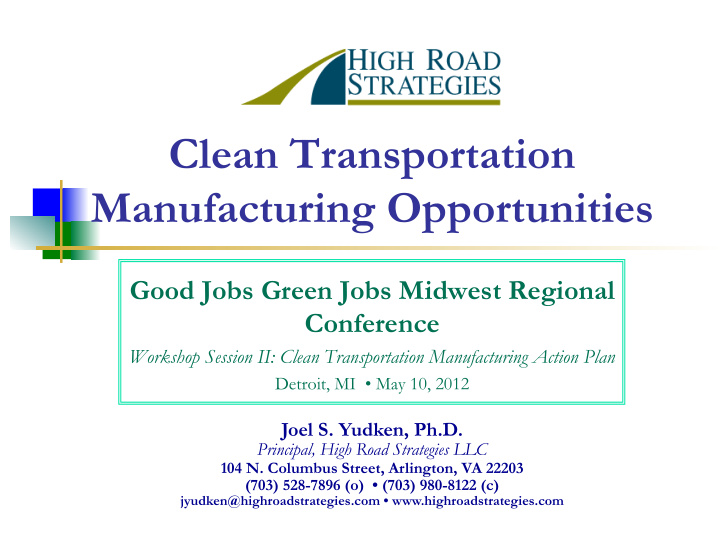



Clean Transportation Manufacturing Opportunities Good Jobs Green Jobs Midwest Regional Conference Workshop Session II: Clean Transportation Manufacturing Action Plan Detroit, MI • May 10, 2012 Joel S. Yudken, Ph.D. Principal, High Road Strategies LLC 104 N. Columbus Street, Arlington, VA 22203 (703) 528-7896 (o) • (703) 980-8122 (c) jyudken@highroadstrategies.com • www.highroadstrategies.com
Workers in America and across the world. . . share a bold vision for a cleaner environment that carries the promise of millions of good green jobs and a revival of the middle class and domestic manufacturing. The trade union movement wants an environmental economic development strategy that achieves a just transition to a green economy. — AFL-CIO Executive Committee Resolution 10, 2009
Clean Manufacturing Opportunities Clean energy manufacturing—OEMs and supply chains for renewable energy systems Clean energy transportation systems—OEMs and supply chains for: Advanced Fuel Vehicles (EVs, hybrids) Public transit—rail and busses Hybrid trucks Energy efficiency—applications; OEMs & supply chains: Industrial energy efficiency (IEE) Buildings—residential, commercial, public Equipment manufacturers (CHP, motors, etc.)
Policy Drivers Creating demand for clean energy systems Energy portfolio standards (RPS, EERS) End-use product energy standards (equipment efficiency; fuel standards) Direct public investments Financial and tax incentives Assuring domestic manufacturing capacity Financial and tax incentives Technical assistance Domestic content Workforce development
TMAP Recommendations Invest $30 billion in public transit, $10 billion in intercity rail annually Expand competitive, mode-neutral financing approaches to leverage state, local, and private transportation investment Develop a national freight plan and upgrade freight vehicle fleet Help manufacturers retool and invest in production of transit systems, vehicles, clean trucks, and component parts Increase transparency and accountability of standards and provide domestic content incentives Encourage product standardization and improve procurement Invest in R&D for next generation transit, rail, and trucking technologies
Transportation Manufacturing Jobs Current public transit investments: >1.9 million jobs, i.e., vehicle operators and technicians, construction, manufacturing, others Nationwide, public transit bus, clean truck, passenger and transit rail sector support nearly 50,000 manufacturing jobs Transportation manufacturing supply chain spread across all 50 states, at more than 375 manufacturing facilities. Largest manufacturing industries: Railroad rolling stock, cement and concrete, motor vehicle parts, iron and steel mills, steel products, nonferrous metals, motor vehicle bodies and trailers, metalworking machinery, aluminum, engine turbine and power transmission TMAP job impacts ( Economic Policy Institute ) total of 3.7 million direct and indirect jobs, over 600,000 in manufacturing over 6 years Mostly middle class jobs created; over half workers with a high school education or less; wages in middle of wage distribution; high share of unionized jobs Transit and rail investments create 69% more manufacturing jobs per dollar than traditional mix of federal transportation spending
Clean Transportation Manufacturing— “Heartland” States Current ¡No. ¡ Poten4al ¡No. ¡Jobs ¡ Manufacturing ¡ State ¡ Created: ¡TMAP ** ¡ Facili4es * ¡ Ohio ¡ 35 ¡ ¡33,385 ¡ ¡ Illinois ¡ 38 ¡ ¡29,770 ¡ ¡ Pennsylvania ¡ ¡ 34 ¡ ¡29,079 ¡ ¡ Michigan ¡ 33 ¡ ¡25,969 ¡ ¡ Indiana ¡ 39 ¡ ¡23,572 ¡ ¡ Wisconsin ¡ 16 ¡ ¡22,236 ¡ ¡ Minnesota ¡ 13 ¡ ¡15,126 ¡ ¡ * Duke University/CGGC ** EPI
Manufacturing Value Chains Propulsion ¡ Passenger ¡ Passenger ¡& ¡Transit ¡ Components ¡ Main ¡Materials ¡ Coaches/ Transit ¡& ¡ Electronic ¡Systems ¡ Parts ¡Inputs ¡ ¡ Locomo4ves ¡ Rail ¡ Body ¡& ¡Interior ¡ Major ¡Components ¡ Public ¡ Raw ¡Materials ¡ (engines, ¡axles, ¡etc., ¡ ¡ Transit ¡ Semi-‑Finished/ System ¡Builders ¡ Leading ¡OEMS ¡ Finished ¡Product ¡s (chassis, ¡electric/ Buses ¡ electronic, ¡body ¡& ¡ ¡ ¡ interior) ¡ Materials ¡ Electric ¡ Components ¡ Electric ¡Hybrid ¡ Hybrid ¡ (energy ¡storage ¡ Truck ¡OEMS ¡ System ¡Developers ¡ systems, ¡electric ¡ Trucks ¡ motor/generators, ¡ electronics ¡& ¡SW) ¡ ¡ Hydraulic ¡Hybrid ¡ Materials ¡ Hydraulic ¡ Truck ¡Technology ¡ Components ¡ Hybrid ¡ Truck ¡OEMs ¡ Providers ¡ (energy ¡storage ¡ Developing ¡ Trucks ¡ System ¡ systems, ¡pump ¡ Hydraulic ¡Hybrids ¡ motors, ¡control ¡ Developers/ ¡ ¡ systems ¡& ¡SW) Suppliers ¡ Source: Duke University/CGGC
Passenger & Rail Transit Manufacturing Locations
Barriers/Opportunities Rail/Bus Transit Unpredictable demand—government (federal, state, local) budgets uncertain US invests more on highway and air transport than rail Foreign-owned OEMs/suppliers dominate U.S. value chain (Buy America does matter!) Foreign OEMs/suppliers with U.S. operations perform higher value- added activities in own countries Hybrid Trucks (Medium to Heavy-Duty) US well-positioned to take leadership At least 25 US-based truck makers, 14 US hybrid system developers Cost and technology issues (battery “pinch-point”) Government R&D $ important
Recommend
More recommend